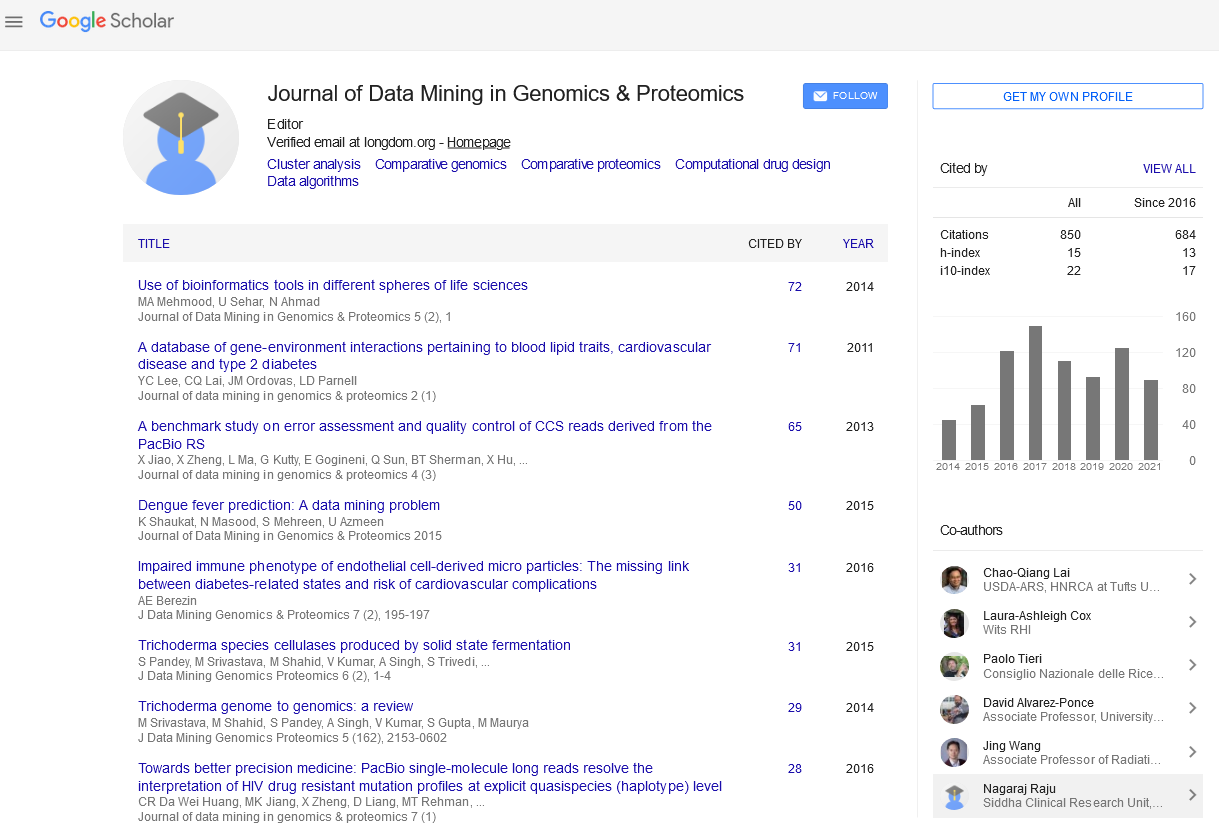PMC/PubMed Indexed Articles
Indexed In
- Academic Journals Database
- Open J Gate
- Genamics JournalSeek
- JournalTOCs
- ResearchBible
- Ulrich's Periodicals Directory
- Electronic Journals Library
- RefSeek
- Hamdard University
- EBSCO A-Z
- OCLC- WorldCat
- Scholarsteer
- SWB online catalog
- Virtual Library of Biology (vifabio)
- Publons
- MIAR
- Geneva Foundation for Medical Education and Research
- Euro Pub
- Google Scholar
Useful Links
Share This Page
Journal Flyer

Open Access Journals
- Agri and Aquaculture
- Biochemistry
- Bioinformatics & Systems Biology
- Business & Management
- Chemistry
- Clinical Sciences
- Engineering
- Food & Nutrition
- General Science
- Genetics & Molecular Biology
- Immunology & Microbiology
- Medical Sciences
- Neuroscience & Psychology
- Nursing & Health Care
- Pharmaceutical Sciences
Editorial - (2020) Volume 11, Issue 1
Data Mining in Genomics and Proteomics for a New Era of Computational Biology
Simon Daefler*Received: 25-Mar-2020 Published: 15-Apr-2020
Data mining refers to the processes of discovering large data sets which involves the methods of intersection of statistics, Data base systems and machine learning. Genomics refers to the study of structure, function, evolution, and mapping of genomes. Proteomics refers to study of proteins as proteins are the essential things for the growth of function and growth of living organisms.
Data Mining in Genomics and proteomics correlates the interface of computer science along with the biological aspects which paves an easy and essential way for future biological researchers throughout the world.
Journal of Data Mining in Genomics and Proteomics is an International peer reviewed journal which mainly aims in disseminating the quality articles in all areas related to Genomic Data Warehousing, Genomic Data Mining, Genomic And Proteomics Data Services, Data Mining Applications In Genomics etc.,
This Journal successfully completes 10 years in publication of quality research work globally being an Editorial board member for this prestigious journal I hereby discloses the scientific trends and research updates of our journal.
An article titled “ Nitrogen Base Sequence Analysis and Characterization of Mutations in Gene Coding Region That Can Lead to High Levels of Resistance in Tuberculosis Patients in Jayapura, Papua Province-Indonesia ” which was written by Prof. Yohanis Ngili which discusses that The disease of tuberculosis in Papua Province, Indonesia [1].
The manuscript revels the aspects of mutations in rpoB512 gene results in causing of high resistance of M. tuberculosis. Most of the mutations occurring in the β-subunit RNA polymerase are found in region I (the position of amino acid residues 505 to 537) and region II (the position of amino acids 562 to 572). These results of analysis suggest that Amino acid changes in this residue caused the greatesteffect on the M. tuberculosis phenotype on the Mtb isolate in Papua Province of Indonesia.
Another article by same Prof. Yohanis Ngili entitled Genetic Mutations in the Papuan Human Mitochondrial Genome: Studies in Gene Control Regions and Gene Coding Using REPLI-g [2]. This manuscript is all about the Study Analysis and DNA mutations in Papuan humans with comparison of several world ethnicities both in coding region and gene control region.
This manuscript revels that mutation analysis shows that there were several mutations in mtG region fragments and most of the mutations outside the D-loop regions are in the ATP6 region and the results of analysis of gene coding region provides that there are enough variability of mutations between tribes in Papua which are quite high and this study is quite interesting to examine more deeply on bioetnoanthropological studies.
REFERENCES
- Tanjung RHR, Ngili Y. Nitrogen Base Sequence Analysis and Characterization of Mutations in Gene Coding Region That Can Lead to High Levels of Resistance in Tuberculosis Patients in Jayapura, Papua Province-Indonesia. J Data Mining Genomics Proteomics. 2019;10(1):1-4.
- Tanjung RHR, Ngili Y. Genetic Mutations in the Papuan Human Mitochondrial Genome: Studies in Gene Control Regions and Gene Coding Using REPLI-g. J Data Mining Genomics Proteomics. 2019;10(1):1-4.
Citation: Daefler S (2020 Data Mining in Genomics and Proteomics for a New Era of Computational Biology. J Data Mining Genomics Proteomics. 11:e129. DOI: 10.35248/2153-0602.20.11.e129
Copyright: © 2020 Daefler S. This is an open-access article distributed under the terms of the Creative Commons Attribution License, which permits unrestricted use, distribution, and reproduction in any medium, provided the original author and source are credited.


